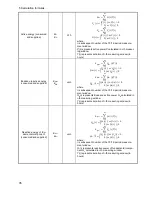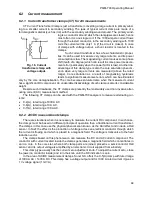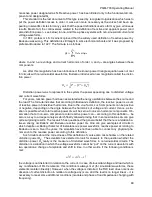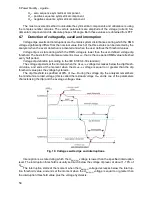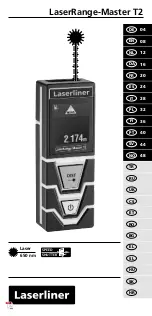
PQM-700 Operating Manual
48
nonactive power designated as N. Reactive power has been limited only to the fundamental com-
ponent and designated Q
1
.
This standard is the last document of this type issued by recognized organization which was to
put the power definition issues in order. It was even more necessary as the voices had been ap-
pearing in scientific circles for many years that the power definitions used so far may give erroneous
results. Most of all, the controversies related to the definition of reactive and apparent power (and
also distortion power
– see below) in one- and three-phase systems with non-sinusoidal current and
voltage waveforms.
In 1987, professor L.S. Czarnecki proved that the widely used definition of reactive power by
Budeanu was wrong. This definition is still taught in some technical schools and it was proposed by
professor Budeanu in 1927. The formula is as follows:
𝑄
𝐵
= ∑ 𝑈
𝑛
𝐼
𝑛
sin 𝜑
𝑛
∞
𝑛=0
where
U
n
and
I
n
are voltage and current harmonics of order
n
, and
n
are angles between these
components.
As, after this magnitude has been introduced, the known power triangle equation was not met
for circuits with non-sinusoidal waveforms, Budeanu introduced a new magnitude called the
distor-
tion power
:
𝐷
𝐵
= √𝑆
2
− (𝑃
2
+ 𝑄
𝐵
2
)
Distortion power was to represent in the system the power appearing due to distorted voltage
and current waveforms.
For years, reactive power had been associated with energy oscillations between the source and
the load. The formula indicates that accordi
ng to Budeanu’s definition, the reactive power is a sum
of reactive power of individual harmonics. Due to the
sin
factor, such components can be positive
or negative, depending on the angle between the harmonics of voltage and current. Hence, a situ-
ation is possible when total reactive power
Q
B
will be zero at non-zero harmonic components. Ob-
servation that at non-zero components, total reactive power can
– according to this definition – be
zero is a key to a deeper analysis which finally allowed proving that in some situations
Q
B
can give
quite surprising results. The research has questioned the general belief that there is a relation be-
tween energy oscillations and Budeanu reactive power
Q
B
. One can give examples of circuits in
which despite oscillating character of instantaneous power waveform, reactive power according to
Budeanu is zero. Over the years, the scientists have not been able to connect any physical phe-
nomenon to the reactive power according to this definition.
Such doubts about the correctness of this definition of course also cast shadow on the related
distortion power D
B
. The scientists have started to look for answers to the question whether the
distortion power
D
B
really is the measure of distorted waveforms in non-sinusoidal circuits. The
distortion is a situation in which the voltage waveform cannot be “put” on the current waveform with
two operations: change of amplitude and shift in time. In other words, if the following condition is
met:
𝑢(𝑡) = 𝐴𝑖(𝑡 − 𝜏)
the voltage is not distorted in relation to the current. In case of sinusoidal voltage and load which is
any combination of RLC elements, this condition is always met (for sinusoidal waveforms, these
elements maintain linearity). However, when the voltage is distorted, the RLC load does not ensure
absence of current distortion in relation to voltage any more, and the load is no longer linear
– it is
necessary to meet some additional conditions (module and phase of load impedance changing with
frequency).
Summary of Contents for PQM-700
Page 85: ...85 Notes...


